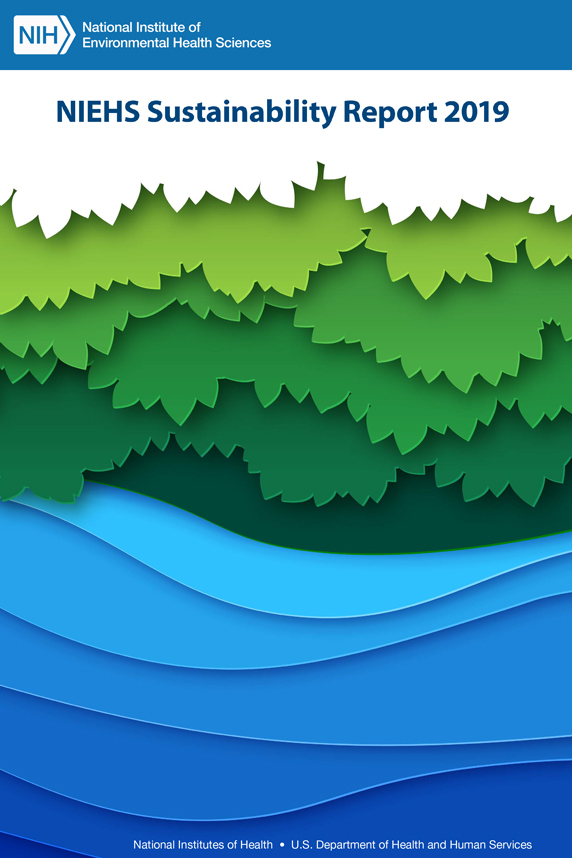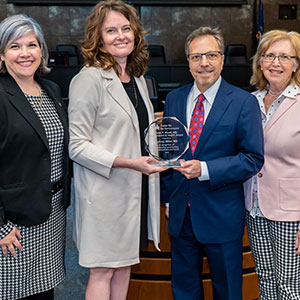 “NIEHS strives to meet or exceed all applicable federal sustainability requirements,” the report states. (Photo courtesy of NIEHS)
“NIEHS strives to meet or exceed all applicable federal sustainability requirements,” the report states. (Photo courtesy of NIEHS)The NIEHS 2019 Sustainability Report, released Jan. 7, details institute efforts and other goals related to sustainable operations, such as the following.
- Further reduce energy use.
- Improve recycling.
- Dispose of hazardous wastes.
- Cut greenhouse gas emissions.
The NIEHS Health and Safety Branch produced the 29-page report, which is the sixth in a biennial series. It covers 2017 and 2018, and assesses progress over the last decade.
NIEHS and National Toxicology Program Acting Director Rick Woychik, Ph.D., highlighted significant findings of the report.
- Energy intensity reduced by nearly 12% over the last four years. Energy intensity is a measure of efficiency across sources, accounting for both cost and energy units.
- Increased solar energy generation.
- Diverted 80% of solid nonhazardous waste from landfills between 2010 and 2018.
- Decreased volume of wastewater discharge by 32%.
- Nearly 30% decrease in carbon dioxide (CO2) emissions from the vehicle fleet.
“The report demonstrates how our operations align with our mission to protect and enhance human health and the environment,” said Paul Johnson, manager of Environmental Protection and Stewardship Programs. Johnson oversaw development of the report.
 “It is our duty to promote environmental stewardship here at the institute,” Woychik said. (Photo courtesy of Steve McCaw)
“It is our duty to promote environmental stewardship here at the institute,” Woychik said. (Photo courtesy of Steve McCaw)NIEHS is the only institute or center in the National Institutes of Health (NIH) to regularly publish a sustainability report about its operations.
“It’s an example of our leadership in sustainability,” said Johnson. “It demonstrates transparency and openness about environmental stewardship.”
“I am especially proud of our Net-Zero Energy (NZE) warehouse and its Leadership in Energy and Environmental Design [LEED] Platinum certification,” said Woychik. “It saved the equivalent of 20 metric tons of CO2 emissions.”
Changes in rules and the weather
Statistics that did not show improvement were influenced by factors beyond the control of NIEHS.
Hazardous waste production increased by more than 9,000 pounds between 2017 and 2018, in large part due to a change in waste management practices.
“Certain liquids that were once permitted to be disposed to the drain began to be collected and shipped off-site for disposal in 2018, such as aqueous liquids from laboratories and rinsate from imaging processers,” said Johnson.
 Johnson chairs the NIEHS Environmental Awareness Advisory Committee, which advises management on sustainability issues. (Photo courtesy of Steve McCaw)
Johnson chairs the NIEHS Environmental Awareness Advisory Committee, which advises management on sustainability issues. (Photo courtesy of Steve McCaw)On-site C02 emissions remained below the Environmental Protection Agency reporting threshold, revealing a downward trend. Then, in 2018, emission levels returned to 2008 levels. The data suggest the increase was the result of extreme temperatures that led to higher winter fuel oil use and summer electricity demand.
Installation of more efficient chillers, which provide cooling, in 2013 and 2018 at the Central Utility Plant kept electricity demand from being even higher.
The report noted that the NIEHS Climate Resilience Report of May 2018 was the first such report at NIH. The report’s planning team evaluated vulnerabilities to extreme changes in weather and climate, enabling NIEHS to adapt.
“NIEHS still faces a major challenge in reducing greenhouse gas emissions,” said Woychik. “We must look for every opportunity to limit our energy consumption and shift to renewable power.”
Going forward
Woychick highlighted action items necessary for future sustainability gains.
- Further modernize the data center to lower energy demands.
- Add electric fleet vehicles to reduce reliance on fossil fuels.
- Install a condensate capture and reuse system to decrease water demand.
Overall, the report reflects the unique sustainability challenges facing the principal environmental institute at NIH.
“Biomedical research is resource- and energy-intensive. We understand that we face environmental challenges even as we try to find environmental solutions,” said Johnson. “This report says: Here’s what we’re doing about it.”
(John Yewell is a contract writer for the NIEHS Office of Communications and Public Liaison.)










